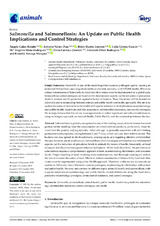Salmonella and Salmonellosis: an update on public health implications and control strategies
Autor
Galán Relaño, Ángela
Valero Díaz, Antonio
Huerta Lorenzo, Belén
Gómez-Gascón, Lidia
Mena Rodríguez, María de los Ángeles
Carrasco Jiménez, Elena
Pérez Rodríguez, Fernando
Astorga Márquez, Rafael J.
Editor
MDPIFecha
2023Materia
SalmonellaSalmonellosis
Animal health
Public health
Food chain
Predictive microbiology
Antimicrobial resistance
Control strategies
One health
METS:
Mostrar el registro METSPREMIS:
Mostrar el registro PREMISMetadatos
Mostrar el registro completo del ítemResumen
Salmonellosis is globally recognized as one of the leading causes of acute human bacterial gastroenteritis resulting from the consumption of animal-derived products, particularly those derived from the poultry and pig industry. Salmonella spp. is generally associated with self-limiting gastrointestinal symptoms, lasting between 2 and 7 days, which can vary from mild to severe. The bacteria can also spread in the bloodstream, causing sepsis and requiring effective antimicrobial therapy; however, sepsis rarely occurs. Salmonellosis control strategies are based on two fundamental aspects: (a) the reduction of prevalence levels in animals by means of health, biosecurity, or food strategies and (b) protection against infection in humans. At the food chain level, the prevention of salmonellosis requires a comprehensive approach at farm, manufacturing, distribution, and consumer levels. Proper handling of food, avoiding cross-contamination, and thorough cooking can reduce the risk and ensure the safety of food. Efforts to reduce transmission of Salmonella by food and other routes must be implemented using a One Health approach. Therefore, in this review we provide an update on Salmonella, one of the main zoonotic pathogens, emphasizing its relationship with animal and public health. We carry out a review on different topics about Salmonella and salmonellosis, with a special emphasis on epidemiology and public health, microbial behavior along the food chain, predictive microbiology principles, antimicrobial resistance, and control strategies.

